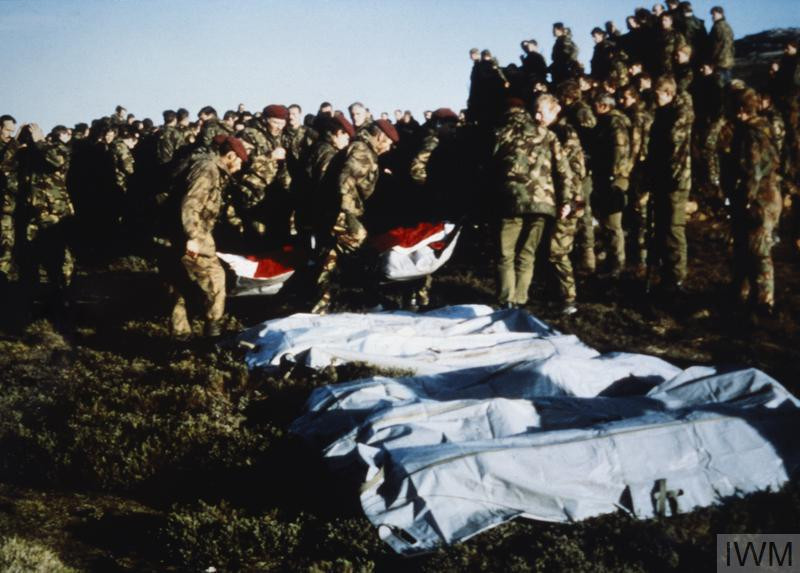With Major Chris Keeble now in command of 2 Para, Lt Col H Jones having been killed during a daring charge up a small ravine the day before in a bid to regain the initiative, a different approach was being adopted to end the fierce fighting at Goose Green, the third largest settlement in the Falklands with around 100 residents at the time.
More than 1,000 Argentine troops were positioned in the Goose Green and Darwin area on the narrow isthmus that connects the peninsula of Lafonia to the rest of East Falkland.
Although it was close to the British landing beaches on San Carlos Water and had an airfield, it was not regarded as a vital military target to those running Operation Corporate, the campaign to retake the Falkland Islands – but there was an appetite back in London for a victory to boost morale, and the Battle of Goose Green did just that.
Shortly after midnight on Saturday 29 May, through a delegation of two Argentine prisoners of war, Maj Keeble offered the garrison holed up at Goose Green a stark choice – surrender or suffer a devastating bombardment.
With insufficient reinforcements available, and the proposition of the British sitting out of their reach and unleashing shells, bombs and mortars onto their heads almost at will, the Argentine commander agreed to talk terms.
By morning agreement had been reached; the Argentine troops formed up for a final, brief parade, laid down their arms and were taken prisoners of war.
By that time a pre-dawn attack had been carried out on San Carlos Water by the Argentine Air Force using English Electric Canberra medium bombers, followed by a wave of Daggers, one of which was shot down by a Rapier anti-aircraft battery, but they proved little more than harassment to the Royal Navy.
An audacious long-range attack was carried out on a British merchant ship far out into the South Atlantic when an Argentine C-130 Hercules dropped eight bombs onto the tanker MV British Wye, 400 miles north of South Georgia.
The tanker had been taken up from trade by the MOD to supply ships of the British task group, and therefore would have been regarded as a legitimate target.
Fortunately, seven of the bombs missed, and the eighth bounced off the deck without exploding.
With the cross-decking of troops heading west and survivors heading north having been completed, a number of ships left South Georgia on 29 May.
Queen Elizabeth 2 steamed towards the UK carrying the ship’s companies of HMS Ardent, HMS Coventry and HMS Antelope, arriving in Southampton on June 11, while Canberra and Norland sailed in the direction of the Falklands, transporting members of 5 Infantry Brigade to join the fighting.
Small Fleet tanker RFA Blue Rover also sailed from South Georgia to join the main Task Group in the Falklands Total Exclusion Zone (TEZ).
Over in Falkland Sound and San Carlos Water, CPO (D) Trotter and his colleagues from Fleet Clearance Diving Team 3 finally managed to remove the unexploded bomb that had struck Landing Ship Logistic RFA Sir Lancelot five days earlier.
The team spent 22 hours solidly working on the problem of a live bomb in an awkward location, and their solution was to remove an entire cabin from the deck above to allow the bomb to be removed – very gently – by use of cutting gear, a chain hoist and sheerlegs.
It was then lowered to the sea bed.
CPO(D) Trotter was subsequently awarded the Distinguished Service Medal (DSM) and the team received two Mentions in Dispatches and four Commander-in-Chief’s Commendations for Brave Conduct.
But it wasn’t all good news on 29 May, as a precious Sea Harrier of 801 Naval Air Squadron was lost from aircraft carrier HMS Invincible in rough seas well to the east of the Falklands.
The Sea Harrier was moving into position on the flight deck, ready for take-off, when Invincible rolled heavily in rough seas and the aircraft slid sideways off the ship and into the ocean, where it rapidly sank; the pilot managed to escape and was recovered safely.
Today’s image from the Imperial War Museum collection (© IWM FKD 1287) shows the burial of the dead of 2 Para following the capture of Goose Green on 28 May 1982.
* These posts can only give a brief sense of what was a complex and fast-moving situation 40 years ago, and cannot cover the involvement of every ship, squadron and unit in detail – for a much more comprehensive account see the Falklands section of naval-history.net at https://www.naval-history.net/NAVAL1982FALKLANDS.htm
